
Planning work from home schedule for business growth: The first step in creating your work-from-home timeline is determining the boundaries of your workday. Consider your professional responsibilities and the hours your supervisors expect you to be accessible. Then, set your start and end times to ensure you can collaborate effectively with team members and produce high-quality results. For instance, if you are a freelance photographer, scheduling your hours in the afternoon and evening may be ideal, as clients often book sessions later in the day. Conversely, if you work in information technology, beginning your day earlier may help you respond promptly to user inquiries. Record your preferred start time at the top of your schedule and your intended finish time at the bottom.
Home business planning strategy begins with practicing how you communicate your goals and brand message. Clearly articulate the problem or need your business solves and explain why it matters to your target audience. This clarity makes your marketing and sales efforts far more effective. It also becomes invaluable when seeking funding or applying for financial support for your small business. Knowing your objectives in detail helps you map out a plan to achieve them reliably. Many ideas sound appealing in conversation or on paper, but when you examine the numbers—like revenue streams and expenses—some may not hold up. Creating a business plan gives you the framework to develop a financial model. It allows you to explore both best- and worst-case scenarios, ensuring your concept is financially viable and well-founded.
How to plan a home office layout for success: If you don’t have the luxury of a full room for your home office, or your space is tight, it’s important to maximize every inch you have. Often, a customized approach to storage and furniture is the most effective. Consider exactly what you need from your workspace and design around those requirements. Standard, ready-made office furniture may not suit the dimensions of your room. “While built-in units are ideal for a dedicated office, in smaller spaces, opt for simple shelving to hold books and showcase items that motivate you,” recommends Debbie Leigh.
Business planning at home tips: Depending on your location, your city or county might have specific rules for running a business from your residence. In most cases, residential zoning permits home-based businesses as long as the property is mainly used as a home and your business doesn’t cause disruptions to neighbors. It’s wise to review local regulations to understand any restrictions on operating a business from home. One of the most frequent requirements for small businesses is obtaining the proper licenses. You’ll likely need a general business license, which authorizes you to conduct business in your area. Additionally, if your business involves home healthcare, financial advising, or legal services, you may be required to secure a professional license from the state.
Best practices for home office productivity: Set aside a dedicated space for your home office. Choosing a central spot keeps work materials within reach and prevents important items from getting misplaced, saving both time and stress. The space doesn’t need to be elaborate, but it should provide enough room to carry out tasks efficiently. Design your workspace to support your peak productivity. Make sure you have a comfortable chair, a tidy desk, and ample lighting. Add personal touches like plants, artwork, or other items that inspire you. Both physical comfort and an aesthetically pleasing environment can significantly enhance your focus and the quality of your work. Consider noise levels carefully. Quiet surroundings boost concentration and maintain a professional atmosphere during calls or video meetings
Set up a home office for professional performance by choosing the right furniture to ensure your workspace is comfortable and supports your health, helping to prevent back pain. Working long hours with only brief breaks can put significant strain on your body, so a well-designed setup is essential. Both organizational and personal ergonomics are often overlooked in work environments. Long periods in static positions can negatively affect your health. Conducting an ergonomic assessment of your office and learning how to sit and work properly can greatly improve comfort and well-being. An effective work-from-home ergonomic setup focuses on adapting the workspace to the user’s needs. Select a chair and desk that match your body dimensions and ensure the environment is well-lit, quiet, and at a comfortable temperature.
Home office design ideas for business owners focus on creating areas that go beyond just a break from work—they offer a chance to pause and reflect in an environment that contrasts with the main workspace. These zones can take the form of a small library, a cozy nook, or a corner styled differently from the surrounding office. Most importantly, these spaces should be designed with the user in mind. They can be especially valuable for neurodiverse team members, so careful attention to lighting and sound is essential. Location is also key: employees are more likely to use spaces that are tucked away from the central office area.
Organizing your home workspace for success begins with making sure everything has its place. Whether it’s a physical item like a document or a digital file on your computer, a lot of time is wasted each day when you can’t quickly locate what you need. Use folders, storage boxes, and other organizing tools to keep loose papers and miscellaneous items from piling up on your desk or elsewhere. Discard anything that isn’t essential, and if you’re unsure whether you might need a document later, scan it and save a digital copy before tossing the original. Maintaining a clean, sanitized desk is especially important today, but the advantages go beyond hygiene. You can’t properly clean a cluttered workspace, so committing to a tidy area naturally encourages you to keep your space organized.
How to Plan Daily Home Business Tasks: Sometimes it feels like there just aren’t enough hours in the day. To manage this, try thinking of your day as a series of 24-hour blocks. Breaking your day into segments allows you to dedicate specific time to work, personal activities, meals, and creative projects. When you know exactly how your time is being spent, the feeling of being constantly rushed diminishes. Creating a daily plan is essential for managing time effectively. With a structured schedule, you can set yourself up for success—even on days when your energy or focus is low. Every day, you handle a mix of work responsibilities and personal tasks. Keeping all of these in your head can be overwhelming and often makes it harder to get things done. This is where a daily schedule comes in. By reserving blocks of time in your calendar for each task, you can see exactly what needs to be accomplished over the next 24 hours.
Home business workflow planning involves mapping out the series of tasks and processes needed to complete a particular project or business activity. Reviewing workflow examples can offer valuable insights into organizing your own workflow strategies effectively. By examining project workflow samples, you can spot recurring patterns, adopt best practices, and recognize potential mistakes to avoid in your workflows. Utilizing the appropriate workflow software can greatly improve how you document and carry out your workflow strategies. Tools that provide features like workflow templates allow businesses to quickly implement proven approaches and adjust workflows to their specific requirements. These templates act as a starting point, letting you modify each step to suit your individual processes. Additionally, a well-organized workflow plan enhances transparency and responsibility while making employee training and onboarding faster and more efficient.



